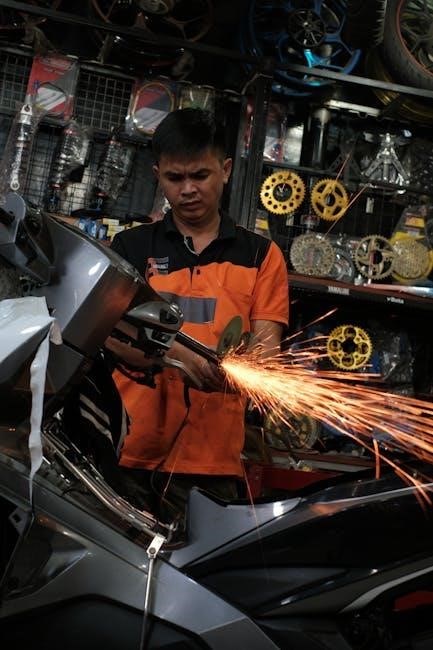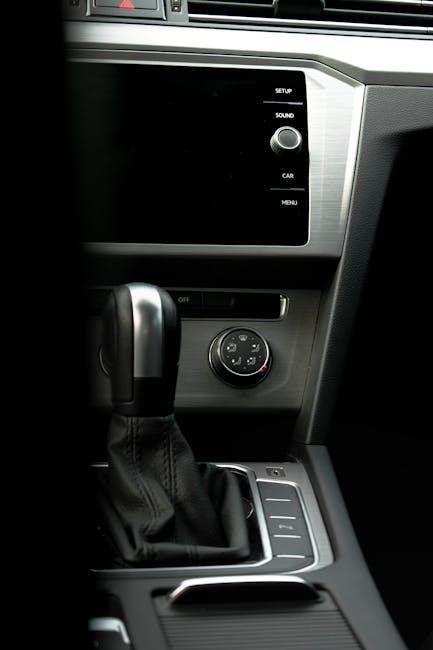Motorcycles are primarily manual, but automatic options exist, catering to different riding preferences and needs. Manuals offer control and fuel efficiency, while automatics provide ease, especially in traffic.
1.1 Overview of the Topic
Motorcycles are predominantly manual, but automatic and semi-automatic options are gaining popularity. Manuals offer precise control and better fuel efficiency, while automatics provide ease of use, especially in heavy traffic. Understanding the differences is crucial for riders to choose the best fit for their skills, preferences, and riding conditions. This guide explores both types, their mechanisms, and key considerations for riders.
1.2 Importance of Understanding Motorcycle Transmissions
Understanding motorcycle transmissions is crucial for safe and efficient riding. It helps riders master control, maintain their bike, and troubleshoot issues. Knowledge of manual and automatic systems ensures proper gear shifting, reduces wear and tear, and enhances overall performance. This understanding also aids in making informed decisions when purchasing or upgrading a motorcycle, tailored to individual riding styles and preferences.

Basics of Manual Transmission Motorcycles
Most motorcycles feature manual transmissions, requiring riders to shift gears using a clutch and gear lever. This system provides control over speed and torque, enhancing performance and fuel efficiency.
2.1 What is a Manual Transmission?
A manual transmission is a type of gearbox that requires the rider to manually change gears using a clutch lever and a gearshift. It typically features multiple gears, allowing for precise control over speed and torque. This system is common in motorcycles, offering improved fuel efficiency and performance, especially for experienced riders who value control and responsiveness while driving.
2.2 How Manual Transmissions Work
A manual transmission requires the rider to engage and disengage the clutch lever, located on the handlebar, to shift gears using the gearshift pedal. Neutral gear is typically found between first and second gears. As the rider accelerates, they press the clutch, shift into higher gears, and release the clutch smoothly. This process allows the rider to control power delivery and torque, optimizing performance and efficiency. Practice is essential to master this skill.

Basics of Automatic Transmission Motorcycles
Automatic motorcycles simplify riding by eliminating manual gear shifting. They are less common than manuals but offer ease of use, especially for beginners or urban riders.
3.1 What is an Automatic Transmission?
An automatic transmission on a motorcycle is a type of gearbox that changes gears without manual intervention. It uses a torque converter or clutch system to automatically shift gears based on speed and engine RPM, providing a smoother and more convenient riding experience. This system is designed to reduce rider effort, especially in stop-and-go traffic.
3.2 How Automatic Transmissions Work
Automatic transmissions in motorcycles use a torque converter or clutch system to automatically shift gears based on speed and engine RPM. Sensors detect riding conditions, and a control module activates gear changes seamlessly. This system eliminates the need for manual shifting, providing a smoother and more relaxed riding experience, especially in heavy traffic or for less experienced riders.
Comparison of Manual vs. Automatic Motorcycles
Manual motorcycles offer better control and fuel efficiency, appealing to experienced riders, while automatics provide ease of use, ideal for beginners or city commuting, balancing performance and convenience.
4.1 Key Differences
Manual motorcycles require riders to actively shift gears using a clutch and gear lever, offering precise control and better fuel efficiency. Automatic motorcycles, however, use a torque converter or continuously variable transmission (CVT) to automatically adjust gears, simplifying operation and reducing rider fatigue, especially in heavy traffic. This fundamental difference in operation caters to distinct riding styles and preferences, impacting both performance and ease of use.
4.2 Riding Experience
Manual motorcycles offer a more engaging riding experience, requiring riders to shift gears and use the clutch, providing better control especially at low speeds. Automatics simplify the ride, reducing fatigue in heavy traffic. The choice between manual and automatic depends on personal preference, riding conditions, and the desired level of involvement in the riding process.
Pros and Cons of Manual Motorcycles
Manual motorcycles offer better control, fuel efficiency, and a more engaging ride. However, they require skill to operate, can be inconvenient in heavy traffic, and may cause fatigue during frequent gear shifts, making them less suitable for beginners or urban commuting.
5.1 Advantages
Manual motorcycles offer precise control over gear shifts, allowing riders to optimize acceleration and speed. They are typically more fuel-efficient and cost-effective to purchase and maintain. Manuals also provide an engaging, immersive riding experience, fostering a stronger connection between the rider and the bike. Additionally, they are lighter and simpler in design, which can enhance performance and handling for experienced riders.
5.2 Disadvantages
Manual motorcycles require more skill and practice to master, as riders must manage clutch and gear shifts. This can be challenging for beginners and may lead to stalling, especially in heavy traffic or inclines. Additionally, constant clutch engagement can be physically demanding on long rides, and the complexity of manual transmissions may deter those seeking simplicity and ease of use.
Pros and Cons of Automatic Motorcycles
Automatic motorcycles offer ease of use and reduce the learning curve, making them ideal for beginners and urban commuting, though they may lack the control of manuals.
6.1 Advantages
Automatic motorcycles simplify riding by eliminating manual gear shifting, reducing the learning curve for beginners. They are ideal for urban commuting, as they minimize rider fatigue in heavy traffic. The ease of operation allows riders to focus more on road awareness, enhancing safety. Additionally, automatics are great for those who prefer a more relaxed and less physically demanding riding experience.
6.2 Disadvantages
Automatic motorcycles generally have higher purchase prices compared to manual models. They often lack the fuel efficiency and performance capabilities of manual transmissions, which can be a drawback for experienced riders seeking optimal control. Additionally, automatics may not suit all types of riding, particularly for those who prefer the engagement and precision of manual gear shifting.
Maintenance and Care
Regular maintenance is crucial for both manual and automatic motorcycles. Manuals require consistent clutch and gear checks, while automatics need fluid and belt replacements to ensure smooth operation.
7.1 Manual Transmission Maintenance
Regular manual transmission maintenance involves checking clutch fluid levels, inspecting the clutch cable for wear, and ensuring gear engagement is smooth. Lubricating the gearbox and replacing worn components like gaskets or seals is essential. Typically, transmission oil should be changed every 10,000 to 15,000 miles to maintain optimal performance and prevent premature wear.
7.2 Automatic Transmission Maintenance
Automatic motorcycle transmissions require less frequent maintenance compared to manuals. Regular checks include ensuring the transmission fluid level is adequate and free from contamination. Flushing and replacing the fluid every 20,000 to 30,000 miles is recommended. Inspecting the belt or chain for wear and ensuring proper tension prevents slippage and extends the system’s lifespan. Early detection of issues prevents costly repairs.
Popular Manual Motorcycles
Iconic manual motorcycles include the Honda CBR500R, Yamaha R6, and Kawasaki Ninja ZX-6R, offering thrilling performance and control for both new and experienced riders alike.
8.1 Iconic Models
Iconic manual motorcycles include the Honda CB750, known as the first superbike, and the Yamaha FZR, celebrated for its lightweight and agility. The Suzuki GSX-R750, or “Gixxer,” is a legendary sportbike, while the Ducati 916 stands out for its stunning design and performance. These bikes have shaped the motorcycle industry and remain popular among enthusiasts for their timeless appeal and riding dynamics.
8.2 Modern Options
Modern manual motorcycles offer advanced technology while retaining the classic appeal of manual shifting. Models like the Yamaha R6, Kawasaki Ninja ZX-6R, and BMW S 1000 RR feature lightweight chassis, aerodynamic designs, and high-performance engines. These bikes cater to both track enthusiasts and everyday riders, blending tradition with innovation for an unparalleled riding experience.
Popular Automatic Motorcycles
Popular automatic motorcycles include the Honda DCT, Yamaha FJR1300, and BMW R 1250 GS, offering smooth, clutch-free riding experiences ideal for both new riders and experienced touring enthusiasts.
9.1 Iconic Models
Iconic automatic motorcycles include the Honda DN-01 and Aprilia Mana 850 GT. The DN-01, introduced in 2008, featured a revolutionary hydraulic-controlled automatic transmission, offering a unique riding experience. The Mana 850 GT, with its sequential manual gearbox, combined automatic functionality with sporty performance. Both models stand out for their innovative designs and appeal to riders seeking ease of use without sacrificing power and style.
9.2 Modern Options
Modern automatic motorcycles like the Honda CM400T and Yamaha FJR1300 combine sleek designs with cutting-edge technology. The Suzuki Burgman 400 offers a refined scooter-like experience, while the Honda Africa Twin DCT provides adventure capabilities with its dual-clutch transmission. These models blend innovative features, such as electronic controls and smooth gear shifts, appealing to riders who value both performance and convenience in their daily commutes or long-distance journeys.
Learning to Ride a Manual Motorcycle
Mastering a manual motorcycle requires practice, starting with clutch control and gear shifting in a safe, open area. Begin on flat surfaces to build confidence and skill.
10.1 Tips for Beginners
Start in a flat, open area to practice clutch and gear control without obstacles. Focus on smooth acceleration and gradual braking. Always wear safety gear, including gloves and a helmet. Practice shifting gears at low speeds to build muscle memory. Use the friction zone to maintain control during starts and stops. Consider enrolling in a motorcycle safety course for professional guidance.
10.2 Resources for Learning
Utilize online forums like Reddit and motorcycle communities for tips and advice. Enroll in Motorcycle Safety Foundation courses for hands-on training. Watch instructional videos on YouTube to visualize techniques. Read motorcycle manuals and guides for detailed insights. Join local riding groups to gain experience and feedback from experienced riders.
Learning to Ride an Automatic Motorcycle
Learning to ride an automatic motorcycle is straightforward, as it eliminates the need for manual shifting, making it ideal for beginners and urban commuting.
11.1 Tips for Beginners
Start in a safe, open area to practice balance and control without obstacles. Focus on smooth acceleration and gradual braking. Familiarize yourself with the bike’s controls and weight distribution. Practice low-speed maneuvers to build confidence. Consider enrolling in a motorcycle safety course for guided instruction. Always wear protective gear, including a helmet and gloves, to ensure safety while learning.
11.2 Resources for Learning
Enroll in a Motorcycle Safety Foundation (MSF) course for structured learning. Visit local training centers for hands-on practice. Explore online forums like Reddit for rider experiences. Check official manufacturer websites for specific model guides. Utilize YouTube tutorials for visual instruction. Read motorcycle manuals for technical insights. Join riding communities for support and knowledge sharing.
Cost Considerations
Manual motorcycles are generally more affordable in purchase price and maintenance. Automatics may have higher initial costs but could offer savings in insurance or long-term upkeep.
12.1 Purchase Price
Manual motorcycles typically have a lower purchase price compared to automatics, making them more accessible for new riders. Automatic motorcycles, while less common, often carry a premium due to their complexity and convenience features. However, prices vary by brand, model, and specifications, with high-end automatics being significantly more expensive than entry-level manuals.
12.2 Long-term Ownership Costs
Manual motorcycles generally have lower long-term ownership costs due to simpler mechanics and better fuel efficiency. Automatic motorcycles may incur higher maintenance expenses, especially for complex systems. Insurance rates can vary, but manuals often see lower premiums. Overall, manuals tend to be more cost-effective over time, while automatics may offer convenience at a slightly higher expense;

Impact of Transmission Type on Safety
Manual transmissions require more rider skill, potentially increasing distraction in traffic, while automatics simplify operation, reducing shifting errors and enhancing focus on road safety for new riders.
13.1 How Transmission Affects Safety
Manual transmissions require active gear shifting, which demands rider attention and coordination, potentially increasing the risk of accidents if not mastered. Automatic transmissions eliminate the need for manual shifting, allowing riders to focus more on road conditions and traffic, thereby enhancing overall safety, especially for inexperienced riders. This reduces distractions and improves reaction times in critical situations.
13.2 Best Practices for Safe Riding
Mastering your motorcycle’s transmission is crucial for safety. Always use both brakes carefully, as improper braking can lead to loss of control. Staying alert and visible to other drivers is essential, especially in heavy traffic. Following traffic rules and maintaining a safe distance reduces accident risks. Continuous learning through safety courses and practice enhances riding skills and overall safety on the road.

Future Trends in Motorcycle Transmissions
Advancements in dual-clutch systems and AI-driven automatic transmissions are expected to dominate, offering seamless shifting and enhanced performance for both manual and automatic motorcycles.
14.1 Emerging Technologies
Emerging technologies in motorcycle transmissions include advanced dual-clutch systems, AI-driven automatic gearboxes, and smart shifting algorithms. These innovations aim to enhance performance, fuel efficiency, and rider comfort. Dual-clutch systems provide faster shifting, while AI optimizes gear changes based on riding conditions. Such technologies are reshaping the future of both manual and automatic motorcycles, offering riders more control and seamless driving experiences.
14.2 Industry Trends
The motorcycle industry is shifting toward automatic transmissions for ease of use, especially in urban commuting. Manual transmissions remain popular among enthusiasts, but automatics are gaining traction. Technological advancements, such as dual-clutch systems and AI-driven gearboxes, are becoming more prevalent, offering riders enhanced performance and convenience. These trends reflect evolving rider preferences and the demand for versatile, modern motorcycles.
15.1 Summary of Key Points
Most motorcycles are manual, offering control and fuel efficiency, while automatics provide ease of use, especially in traffic. Manuals suit experienced riders, while automatics are ideal for beginners. The choice depends on personal preference, riding conditions, and skill level. Research and test rides are essential for making an informed decision. Understanding transmission types enhances safety and riding enjoyment, as outlined in this guide.
15.2 Where to Find More Information
For further details on motorcycle transmissions, explore resources like the Motorcycle Safety Foundation, online forums, and official manufacturer websites. Books, road tests, and licensing manuals also provide in-depth insights. Utilize advanced Google search tips to refine your queries and access reliable information. These sources offer comprehensive guides, maintenance tips, and comparisons to help you make informed decisions about manual or automatic motorcycles.